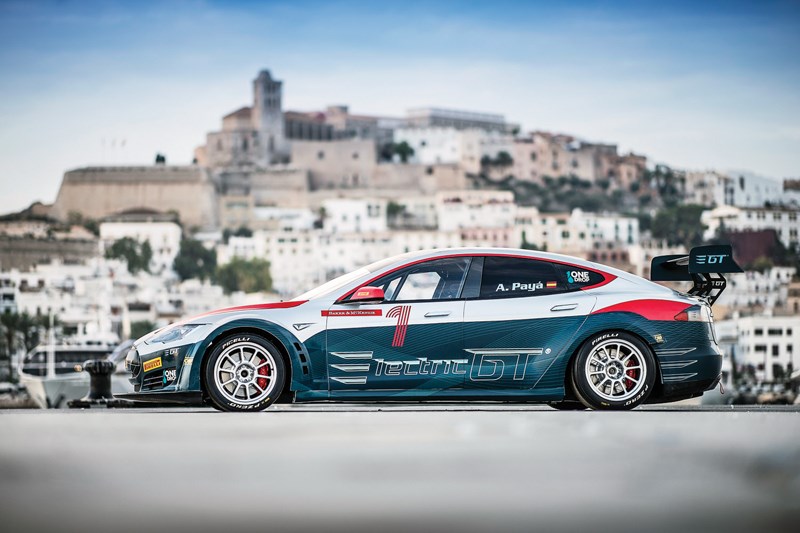A biweekly roundup of automotive news, good, bad and just plain weird:
Electric GT takes the Tesla Model S racing
Something you will see often on the intertubes is the Tesla Model S demonstrating its ability to accelerate very fast in a straight line. Something you will not see a lot of is Model S owners ripping around on a racetrack rather than a dragstrip.
When it comes to fast sedans, the Model S is more AMG eater than Panamera competitor – it can pull decent Gs in the corners, but lacks the cooling and brakes to hack repeated lapping. Notably, racing driver Robb Holland had a go at lapping one around the Nürburgring, and the car went into reduced power mode after about three minutes.
However, it’s not uncommon for a street car to fall on its face when taken racing. And, happily, there’s a company that’s decided to solve the Model S’s problems by releasing a race-spec version.
The Electric GT takes the lightning-fast P100D sedan, swaps out the suspension for a dedicated racing setup, straps on some proper racing brakes, cranks up power to 778 horsepower and 734 foot-pounds of torque, and sheds some 500 kilograms from the curb weight.
Next, Electric GT plans to take their creation racing in a single-make series. Ten two-person teams of drivers will compete in short (60 kilometre) races in Europe and North America, with the racing kicking off this fall.
Racing machines and street cars have very different missions, but getting a car to lap quickly often comes with trickle-down effects, especially where weight savings are concerned.
Electric GT is a small-scale first foray into the field, but there’s nothing bad about seeing the first properly-prepared Tesla take to the track.
First EV finishes the Dakar rally
Further good news for fans of both motorsport and sustainable vehicle development, as the first purely electric car has just completed the 9,000 kilometre Dakar desert rally. Spanish energy company Acconia fielded the purpose-built 4x4, which finished 57th overall.
That’s not what you’d call a podium performance, but even getting to the finish of the Dakar is a huge achievement. The current version of the race takes place over some of the most inhospitable parts of Argentina, Bolivia, and Paraguay, and includes dealing with shifting sands and high altitude.
The machine, unimaginatively called the 100% Ecopowered, comes with a 250 kW electric motor supported by six separate battery modules. The modules can be charged independently – sort of like auxiliary fuel tanks – to make for shorter pit stops on some of the stages, and the motor’s 590 foot-pounds of torque is perfect for ascents.
Long-distance rally isn’t the sort of thing that electric vehicles excel at, but Acconia’s achievement may be thought of as a first step. One bonus of using electric power is that it’s totally unaffected by altitude, unlike conventional combustion engines. Now that the first EVs run the gauntlet, we may see more taking part.
Mazda finds new life in combustion engine
A couple of years ago, I was sitting through a long and complicated technical briefing in a Yokohama boardroom. Mazda engineers laid out their plans for their Skyactiv brand of technologies, and talked at length about stoichiometric ratios, direct-injection misting, and torque ranges at low r.p.m. After about an hour of Powerpoint presentations, one engineer casually dropped a bombshell that had me sitting up in my chair. Now, they’re putting the concept into production.
Essentially, Mazda has figured out how to run a gasoline engine in the same way a diesel engine operates. Let me try to outline how that works without the Powerpoint.
In both gasoline and diesel engines, a mix of fuel and air is ignited to produce an explosion that pushes a piston down and makes power. In a gasoline engine, the ignition comes from a spark; in a diesel engine, the ignition comes from the incredible pressure of squeezing the fuel
air mixture.
Getting a gasoline-air mixture to ignite under pressure takes all kinds of complex equations and a lot of development. However, it yields greatly improved fuel economy. Anybody who currently owns a diesel passenger vehicle will tell you that they get great mileage (especially highway) out of their car.
Imagine, if you will, a next-generation Mazda3 that zips through the corners with that usual Mazda fizz, but can also slog along Highway 1 with similar fuel economy to a VW TDI. EVs are currently great for city use, but the immediate future of the automobile is a blended fleet, and better fuel economy mixed with Mazda fun-to-drive sounds pretty good.
Refreshed Ford Mustang loses V6
After just a couple of years, Ford is freshing up their Mustang with new styling and the addition of their new 10-speed automatic transmission. There’s some improved aerodynamics from the former, and better fuel economy from the latter.
Compared to the Camaro, the Mustang is currently easier to live with (the Camaro’s rear seats are mostly useless), but lags in driving dynamics. The Camaro’s 1LE package is a world beater, with V-8 versions capable of beating up more expensive German competitors, let alone the main rival Mustang.
With that in mind, the Mustang is also getting a revised suspension and new enhancements to the optional Performance Package. If you’re looking for a sporting pony-car that’s not going to swill gas at the pump, there’s extra torque from the 2.3-litre turbo-four which is now the only non-V-8 option. You can get pretty much the full host of performance upgrades on that turbo-’Stang, including magnetically adjustable shocks.
Overall, it’s a worthy upgrade and should be a shot in the arm for Mustang sales. We won’t see a hybrid version for a while just yet, though one’s on the way.
Watch this space for all the week’s best and worst of automotive news, or submit your own auto oddities to [email protected].



